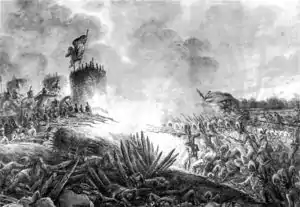List of wars involving Russia
This is a list of wars and armed conflicts in and involving Russia and its predecessors in chronological order, from the 9th to the 21st century.
| History of Russia |
|---|
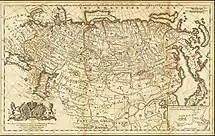 |
|
|
The Russian military and troops of its predecessor states in Russia took part in a large number of wars and armed clashes in various parts of the world: starting from the princely squads, opposing the raids of nomads, and fighting for the expansion of the territory of Kievan Rus'. Following the disintegration of Kievan Rus', the emergence of the Grand Duchy of Moscow and then the centralized Russian state saw a period of significant territorial growth of the state centred in Moscow and then St. Petersburg during the 15th to 20th centuries, marked by wars of conquest in Eastern Europe, the Caucasus, the Volga region, Siberia, Central Asia and the Far East, the world wars of the early 20th century, the proxy wars of the Cold War, and today.
The list includes:
- external wars
- foreign intervention in domestic conflicts
- anti-colonial uprisings of the peoples conquered during the Russian expansion
- princely feuds
- peasant uprisings
- revolutions
Legends of results:
- Victory
- Defeat
- Another result; for example, a treaty or peace without a clear result, status quo ante bellum, indecisive, civil or internal conflict, or result unknown
- Ongoing conflict
Kievan Rus'
This is a list of wars involving Kievan Rus' (c. 9th century–1240).[lower-alpha 1] These wars involved Kievan Rus' (also known as Kyivan Rus'[5]) as a whole, or some of its principalities[lower-alpha 2] up to 1240.[lower-alpha 3]
| Date | Conflict | Combatant 1 | Combatant 2 | Result |
|---|---|---|---|---|
| 1240–1242 | Livonian campaign against Rus' (see also Northern Crusades) | Victory
| ||
| 1268 | Battle of Wesenberg | Both sides claimed victory |
Grand Duchy of Moscow (1263–1547)
This is a list of wars involving the Principality of Moscow (1263–1547), also known as Muscovy.[lower-alpha 6]
| Date | Conflict | Combatant 1 | Combatant 2 | Result |
|---|---|---|---|---|
| 1281–1293/4[30] | Vladimir-Suzdal war of succession (1281–1293)
|
Dmitry of Pereslavl[32] Daniel of Moscow[32] |
Andrey of Gorodets[32] Rostov princes[32] |
Tokhta victory[32]
|
| 1296/8–1302[30] | Struggle for Pereslavl-Zalessky[30] | Daniel of Moscow[30] |
Konstantin of Ryazan[30] |
Muscovite–Tverian victory[30]
|
| 1305–1485 | Muscovite–Tverian wars (series of short wars, mixed with other conflicts) |
Principality of Moscow | Victory
| |
| 1327 | Tver Uprising of 1327 (part of the Muscovite–Tverian wars) |
Alexander of Suzdal |
Golden Horde victory
| |
| 1368–1372 | Lithuanian–Muscovite War (1368–72) (part of the Great Troubles and the Muscovite–Tverian wars) |
Inconclusive | ||
| 1376 | Muscovite–Volga Bulgars war (part of the Great Troubles) |
Volga Bulgaria | Victory | |
| 1377 | Battle on Pyana River (part of the Great Troubles) |
Defeat | ||
| 1378 | Battle of the Vozha River (part of the Great Troubles) |
Victory | ||
| 1380 | Battle of Kulikovo (part of the Great Troubles[35]) |
|
|
Victory for the Rus' principalities coalition[37] |
| 1382 | Siege of Moscow (part of the aftermath of the Great Troubles) |
Defeat[38]
| ||
| 1406–1408 | Lithuanian–Muscovite War (1406–1408) (part of the Muscovite–Lithuanian Wars) |
Hungarian Treaty (1 September 1408)
| ||
| 1425–1453[40] | Muscovite War of Succession[41] | Younger Donskoy line Qasim Khan (1452–3) |
Older Donskoy line Ivan of Mozhaysk (1447–53) |
Vasily II victory[40] |
| 1437–1445 | Ulugh Muhammad's campaign (first Russo-Kazan war) (from Battle of Belyov to Battle of Suzdal) (connected with the Muscovite War of Succession) |
Younger Donskoy line |
Older Donskoy line |
Ulugh victory
|
| 1467–1469 | Qasim War | Victory
| ||
| 1471 | Battle of Shelon | Victory
| ||
| 1478 | Siege of Kazan | Victory
| ||
| 1480 | Great Stand on the Ugra River | Debated[43][44]
| ||
| 1485 | Capture of Tver (1485) (part of the Muscovite–Tverian wars) |
Victory
| ||
| 1492–1494 | First Muscovite-Lithuanian War | Victory | ||
| 1495–1497 | Russo-Swedish War | Inconclusive | ||
| 1500–1503 | Second Muscovite–Lithuanian War | Victory | ||
| 1505–1507 | Russo-Kazan War | Inconclusive | ||
| 1507–1508 | Third Muscovite–Lithuanian War | Inconclusive | ||
| 1512–1522 | Fourth Muscovite–Lithuanian War | Victory | ||
| 1534–1537 | Fifth Muscovite–Lithuanian War | Inconclusive |
Tsardom of Russia (1547–1721)
| Date | Conflict | Location | Russia and its allies | Opponent(s) | Result |
|---|---|---|---|---|---|
| 1552 | Siege of Kazan
.jpeg.webp) Ivan IV enters the defeated Kazan |
Tatarstan | Victory
| ||
| 1552–1556 | Tatar Rebellion | Tatarstan | Tatar rebels | Victory
| |
| 1554–1557 | Ivan the Terrible's Swedish War | Karelia | Inconclusive | ||
| 1556 | Russian conquest of Astrakhan | Astrakhan | Astrakhan Khanate | Victory
| |
| 1558–1583 | Livonian War
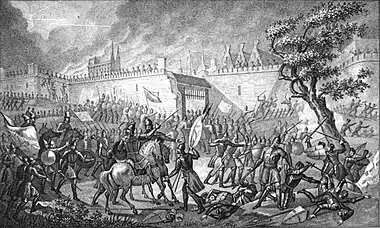 Russia troops besiege Narva in 1558 |
Northern Europe | Livonian Confederation
|
Defeat | |
| 1568–1570 | Astrakhan Expedition | Astrakhan and Azov | Victory
| ||
| 1570–1572 | Ivan the Terrible's Crimean War | European Russia | Victory
| ||
| 1580–1762 | Russian conquest of Siberia
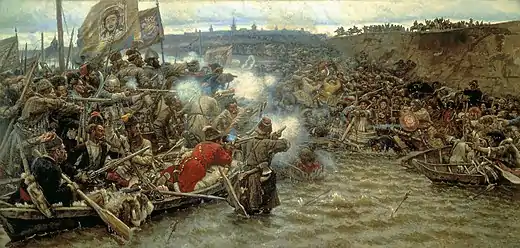 Yermak's Conquest of Siberia |
Siberia |
|
Khanate of Sibir (until 1598)
Native Siberians |
Victory
|
| 1590–1595 | Boris Godunov's Swedish War | Northern Europe | Inconclusive
| ||
| 1605–1618 | Polish invasions of Russia
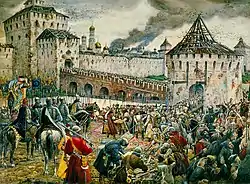 The Poles surrender the Moscow Kremlin to Prince Pozharsky in 1612 |
Russia |
|
Inconclusive
| |
| 1606–1607 | Bolotnikov Rebellion
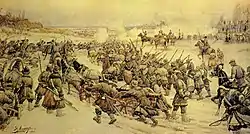 Bolotnikov's battle with the Tsar's army at Nizhniye Kotly near Moscow |
Russia | Rebels under Ivan Bolotnikov | Victory
| |
| 1610–1617 | Ingrian War _-_Nationalmuseum_-_35876.tif.jpg.webp) Depiction of Russian troops in 1611 |
Russia | Defeat | ||
| 1632–1634 | Smolensk War 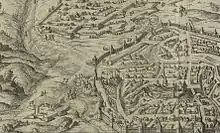 Russian troops storm Smolensk |
Smolensk | Defeat | ||
| 1651–1653 | Alexis I's Persian War | North Caucasus | Defeat | ||
| 1652–1689 | Sino–Russian border conflicts
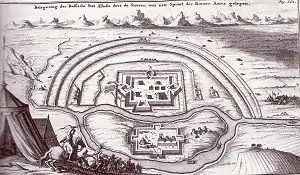 Russian fort under attack by Chinese troops |
Heilongjiang and Amur | Defeat | ||
| 1654–1667 | First Northern War | Eastern Europe | Victory | ||
| 1656–1658 | Second Northern War
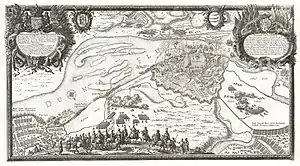 Russian troops besiege Riga in 1656 |
Northern Europe | Inconclusive | ||
| 1662–1664 | First Bashkir Rebellion | Bashkortostan | Bashkir rebels | Inconclusive; political defeat
| |
| 1670–1671 | Razin's Rebellion
 Razin's rebels in Astrakhan |
Russia | Cossacks under Stepan Razin | Victory
| |
| 1676–1681 | Feodor III's Turkish War | Ukraine | Indecisive[45] | ||
| 1683–1700 | Great Turkish War
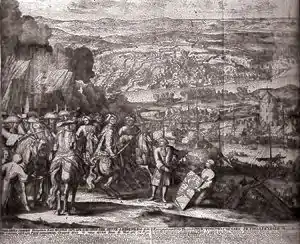 Russian troops capture Azov |
Eastern Europe | Victory
| ||
| 1700–1721 | Great Northern War
.PNG.webp) Russian troops assault the island fortress of Nöteborg  Russian troops capture Narva |
Europe |
|
|
Victory against Sweden |
| Defeat by Turkey | |||||
| 1704–1711 | Third Bashkir Rebellion | Bashkortostan and Tatarstan | Bashkir rebels | Military victory, political defeat
| |
| 1707–1708 | Bulavin Rebellion | Southern Russia | Victory
| ||
| 1717 | Peter the Great's Khivan War | Khanate of Khiva | Defeat
| ||
| 1717–1847 | Kazakh-Russian conflicts | Kazakhstan | Victory
|
Russian Empire (1721–1917)
| Date | Conflict | Location | Russia and its allies | Opponent(s) | Result |
|---|---|---|---|---|---|
| 1722–1723 | Persian Expedition of Peter the Great | Caucasus and northern Iran | Victory | ||
| 1733–1738 | War of the Polish Succession Rhineland
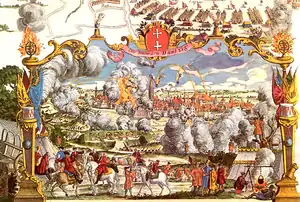 Depiction of the Siege of Danzig by Russian and Saxon forces in 1734 |
Poland | Indecisive | ||
| 1735–1739 | Russo-Austro-Turkish War | Eastern Europe | Victory
| ||
| 1735–1740 | Fourth Bashkir Rebellion | Bashkortostan |
|
Bashkir rebels | Victory
|
| 1740–1748 | War of the Austrian Succession | Europe |
|
|
Inconclusive |
| Victory against Sweden | |||||
| 1756–1763 | Seven Years' War .jpg.webp) Russian troops in Berlin in 1760 |
Europe |
|
White peace
| |
| 1768–1769 | Koliivshchyna Rebellion
 Camp of Haidamakas |
Ukraine | Haidamaky | Victory
| |
| 1768–1772 | War of the Bar Confederation  Krakow capitulates to Suvorov |
Poland | Victory | ||
| 1768–1774 | Catherine the Great's First Turkish War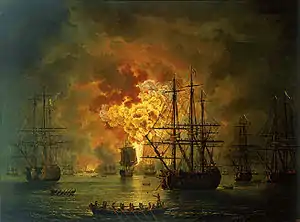 Destruction of the Turkish fleet in the Battle of Chesma |
Eastern Europe, Caucasus and Mediterranean | Victory | ||
| 1773–1775 | Pugachev's Rebellion
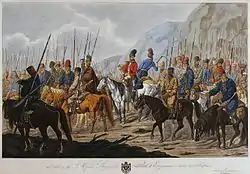 Russian Cossack troops march during the rebellion |
Russia | Rebels under Yemelyan Pugachev |
Victory
| |
| 1787–1792 | Catherine the Great's Second Turkish War
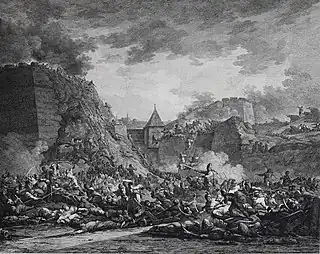 Russian troops storm the fortress of Ochakov |
Eastern Europe | Victory | ||
| 1788–1790 | Catherine the Great's Swedish War
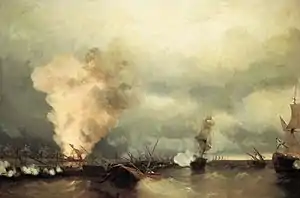 Russian fleet during the Battle of Vyborg Bay |
Finland, western Sweden, and the Baltic Sea | Inconclusive | ||
| 1792 | Catherine the Great's Polish War | Poland | Victory | ||
| 1794 | Kościuszko Uprising | Poland | Victory
| ||
| 1796 | Persian Expedition of Catherine the Great | North Caucasus and South Caucasus | Victory | ||
| 1799–1802 | War of the Second Coalition
 Suvorov victorious at the Battle of Trebbia (1799) |
Europe |
|
Withdrawal in 1799
| |
| 1803–1806 | War of the Third Coalition
 Capture of a French regiment's standard by the cavalry of the Russian Guards |
Europe | Defeat | ||
| 1804–1813 | Alexander I's Persian War
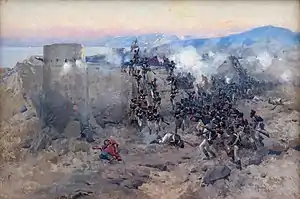 Russian troops storm the fortress of Lankaran |
North Caucasus, South Caucasus and northern Iran | Victory | ||
| 1806–1807 | War of the Fourth Coalition
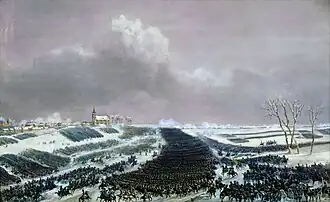 Russia troops clash with French troops at the Battle of Eylau |
Eastern and Central Europe | Defeat | ||
| 1806–1812 | Alexander I's Turkish War
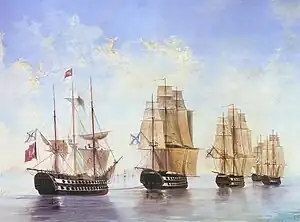 Russian Fleet after the Battle of Athos |
Romania, Moldova, Caucasus and Black Sea | Victory | ||
| 1807–1812 | Anglo-Russian War | Baltic Sea and Barents Sea | Inconclusive | ||
| 1808–1809 | Finnish War
.jpg.webp) Russian troops cross the Gulf of Bothnia on ice |
Finland and Sweden | Victory | ||
| 1809 | War of the Fifth Coalition | Central Europe | Victory (limited involvement) | ||
| 1812 | French invasion of Russia
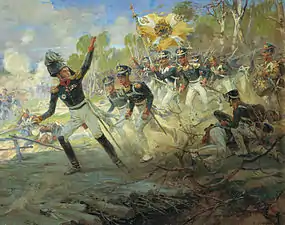 |
Russia | Victory
| ||
| 1813–1814 | War of the Sixth Coalition 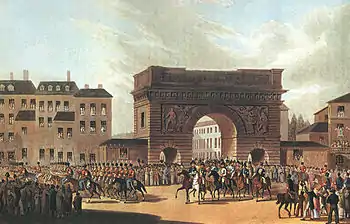 Russian troops entering Paris in 1814 |
Europe |
|
Victory | |
| 1815 | War of the Seventh Coalition | Europe |
|
Victory | |
| 1817–1864 | Caucasian War 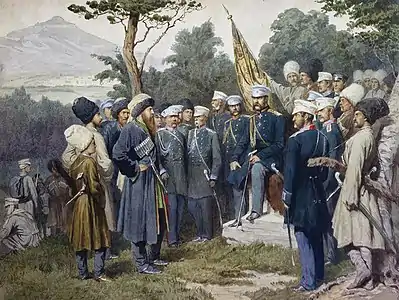 Imam Shamil surrenders to Russian forces |
Caucasus |
|
Victory
| |
| 1825 | Decembrist revolt
 Decembrists at the Senate Square |
Saint Petersburg | Decembrist rebels | Victory
| |
| 1826–1828 | Nicholas I's Persian War 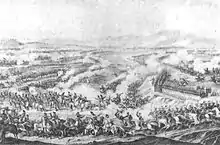 Russian and Persian troops clash near Elisabethpol |
South Caucasus and northern Iran | Victory | ||
| 1827 | Battle of Navarino
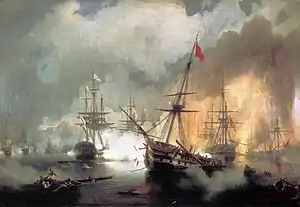 Russian squadron bombarding the Ottoman fleet |
Greece | Victory | ||
| 1828–1829 | Nicholas I's Turkish War  Russian troops besiege Kars in 1828 |
Balkans and Caucasus | Victory | ||
| 1830–1831 | November uprising
 Russian and Polish forces clash during the Battle of Ostrołęka |
Poland | Victory
| ||
| 1839–1841 | Second Turko-Egyptian War | Syria and Lebanon | Victory
| ||
| 1839–1895 | Russian conquest of Central Asia
 Russian troops entering Samarkand in 1868 |
Central Asia |
|
Victory
| |
| 1841 | Gurian rebellion | Georgia | Gurian rebels | Victory
| |
| 1842 | Shoorcha rebellion | Tatarstan and Ulyanovsk | Tatar, Mari and Chuvash peasants | Victory
| |
| 1848–1849 | Hungarian Revolution of 1848
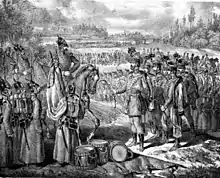 Hungarian troops surrender to the Russians at Világos |
Hungary |
|
|
Victory
|
| 1853–1856 | Crimean War
 Russian troops and French zouaves engaged in hand-to-hand combat at Malakhov Kurgan |
Crimea, Balkans, Caucasus, Black Sea, Baltic Sea, White Sea and Far East | Defeat | ||
| 1858 | Mahtra Rebellion | Estonia | Estonian peasants | Victory
| |
| 1861 | Bezdna Revolt | Tatarstan | Peasants | Victory
| |
| 1863–1864 | January uprising
.jpg.webp) Russian troops in Warsaw during the uprising |
Poland | Victory
| ||
| 1866 | Polish rebellion in Siberia | Siberia | Polish political exiles | Victory
| |
| 1877–1878 | Russo-Turkish War
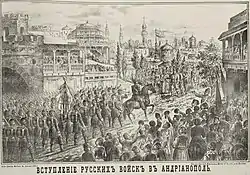 Russian troops entering Adrianople |
Balkans and Caucasus | Victory
| ||
| 1897–1898 | Cretan Revolt (1897–1898) | Crete |
|
Victory
| |
| 1899–1901 | Boxer Rebellion
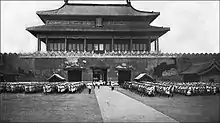 Russian troops in Pekin |
China | Eight-Nation Alliance:
|
Victory | |
| 1902–1906 | Rebellion in Guria | Georgia | Gurian Republic | Victory
| |
| 1904–1905 | Russo-Japanese War
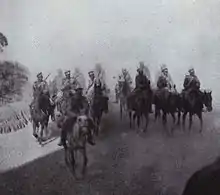 Russian cavalry in a reconnaissance mission during the Battle of Mukden |
Manchuria, Korean Peninsula and Yellow Sea | Defeat | ||
| 1905–1907 | Russian Revolution of 1905
 A barricade erected by revolutionaries in Moscow |
Russia | Supported by: |
Victory
| |
| 1905–1911 | Persian Constitutional Revolution
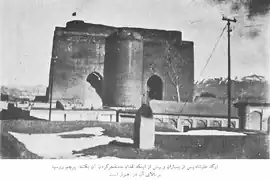 Russian flag over Arg of Tabriz |
Iran |
|
Iranian constitutionalists | Victory
|
| 1914–1917 | World War I
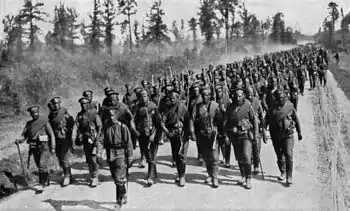 Russian troops going to the front .jpg.webp) Attack of Russian cavalry  Russian trenches in the forests of Sarikamish |
Europe and Asia | Allied Powers:
|
Central Powers: |
Defeat Allied Victory (without Russia)[46][47]
|
| 1917 | February Revolution | Russia | Defeat
|
Russian Republic (1917)
| Date | Conflict | Location | Russia and its allies | Opponent(s) | Result |
|---|---|---|---|---|---|
| 1917 | October Revolution | Russia | Defeat
|
Russian SFSR (1917–1922)
Russia and the Soviet Union (1916–1934)
| Date | Conflict | Location | Russia and its allies | Opponent(s) | Result |
|---|---|---|---|---|---|
| 1916–1934 | Central Asian Revolt
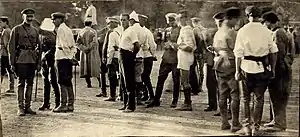 Soviet troops on Turkestan front in 1922 |
Central Asia |
|
Victory
|
Soviet Union (1922–1991)
This is a list of wars involving the Soviet Union (30 December 1922 – 26 December 1991).
| Date | Conflict | Location | Combatant 1 | Combatant 2 | Result |
|---|---|---|---|---|---|
| 1916–1934 | Central Asian Revolt
 Soviet troops on Turkestan front in 1922 |
Central Asia |
|
Victory
| |
| 1924 | August Uprising | Victory
| |||
| 1925–1926 | Urtatagai conflict | Peace treaty
| |||
| 1929 | Sino-Soviet conflict | Victory
| |||
| 1929 | Red Army intervention in Afghanistan (1929) Part of the Afghan Civil War (1928–1929) |
The Soviet Union failed to change the situation in the country | |||
| 1930 | Red Army intervention in Afghanistan (1930) | Victory | |||
| 1932 | Chechen uprising of 1932 | Chechen rebels | Victory
| ||
| 1932–1941 | Soviet–Japanese border conflicts | Victory | |||
| 1934 | Soviet invasion of Xinjiang | Stalemate
| |||
| (1936–39) | Spanish Civil War | Spain | Supported by: Volunteers |
Defeat
| |
| 1937 | Islamic Rebellion in Xinjiang | Victory
| |||
| 1939 | Soviet invasion of Poland (Part of World War II) | Victory
| |||
| 1939–1940 | Winter War (Part of World War II) | Inconclusive
| |||
| 1940 | Occupation and annexation of the Baltic states (Part of World War II) | Victory
| |||
| 1940 | Soviet occupation of Bessarabia and Northern Bukovina (Part of World War II) | Victory
| |||
| 1941–1945 | World War II | Allied Powers:
|
Axis Powers:
|
Victory
| |
| 1944–1960s | Anti-communist insurgencies in Central and Eastern Europe
|
Victory
| |||
| 1945 | Soviet–Japanese War (Part of World War II) | Victory
| |||
| 1950–1953 | Korean War |
|
Ceasefire
| ||
| 1955–1975 | Vietnam War |
|
|
Victory
| |
| 1953 | East German Uprising | Victory
| |||
| 1956 | Hungarian Revolution | Victory
| |||
| 1961–1968 | Vlora Incident | Soviet-Warsaw Pact defeat
| |||
| 1968 | Invasion of Czechoslovakia | Victory
| |||
| 1969 | Zhenbao Island Incident | Victory (status quo ante bellum)[53]
| |||
| 1969–1970 | War of Attrition | Inconclusive
| |||
| 1974–1991 | Eritrean War of Independence |
|
Withdrawal (limited involvement) | ||
| 1975–1991 | Angolan Civil War | Stalemate (limited involvement)
| |||
| 1977–1978 | Ethio-Somali War | Victory
| |||
| 1979–1989 | Soviet–Afghan War | Saqqawists |
Defeat
|
Russian Federation (1991–present)
| Date | Conflict | Location | Russia and its allies | Opponent(s) | Result |
|---|---|---|---|---|---|
| 1991–1993 | Georgian Civil War | Georgia | Supported by |
Victory
| |
| 1991–1992 | South Ossetian War | South Ossetia | Victory
| ||
| 1992–1993 | War in Abkhazia | Abkhazia |
|
Victory
| |
| 1992 | Transnistria War
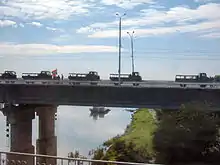 PMR trucks on the bridge between Tiraspol and Bendery |
Transnistria |
|
Victory
| |
| 1992 | East Prigorodny Conflict | North Ossetia-Alania | Victory
| ||
| 1992–1997 | Tajikistani Civil War | Tajikistan |
Supported by |
|
Victory
|
| 1994–1996 | First Chechen War
 A Chechen militiaman takes cover behind a burned-out Russian BMP-2 armoured vehicle |
Chechnya |
|
Defeat[70]
| |
| 1999 | War of Dagestan | Dagestan | Victory
| ||
| 1999–2009 | Second Chechen War
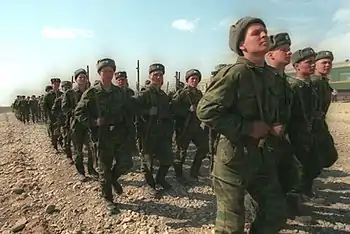 A farewell ceremony for the 331st Airborne Regiment of the 98th Airborne Division withdrawn from Chechnya |
Chechnya | Victory
| ||
| 2008 | Russo-Georgian War
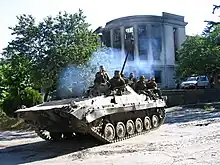 Russian BMP-2 from the 58th Army in South Ossetia |
Georgia, South Ossetia and Abkhazia | Victory
| ||
| 2009–2017 | Insurgency in the North Caucasus
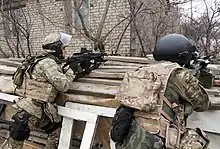 FSB Spetsnaz members during an anti-terrorist operation in Makhachkala, Dagestan |
North Caucasus |
|
Victory
| |
| 2014–present | Russo-Ukrainian War
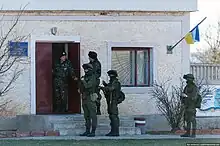 Russian unidentified special forces take control of a Ukrainian military garrison in Crimea 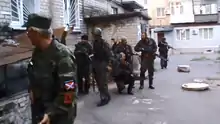 Donetsk People's Republic militiamen checking with civilians in a cellar during the Battle of Ilovaisk (2014) 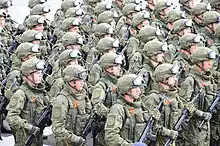 DPR elite Republican Guard troops during the 2018 Victory Day parade in Donetsk |
Ukraine | Supported by |
Supported by: For countries providing aid to Ukraine since 2022, see List of foreign aid to Ukraine during the Russo-Ukrainian War |
Ongoing
|
| 2015–present | Russian military intervention in the Syrian Civil War
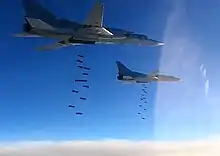 Two Tupolev Tu-22M3s bombing ISIL command posts and weapon warehouses in the Deir ez-Zor area, 2017 .jpg.webp) Sukhoi Su-30 pilot talking to a Russian Air Force technician in the Khmeimim Air Base |
Syria |
Ongoing
| ||
| 2018–present | Central African Republic Civil War
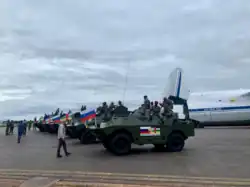 Delivery of Russian BRDM-2 armored vehicles to Central African Republic, October 2020 |
Central African Republic | Ongoing | ||
| 2021–present[74] | Mali War | Mali | Ongoing | ||
See also
- Armed Forces of the Russian Federation – Military forces of the Russian Federation
- History of Russia – History of the Russian Federation
- Military history of Russia – Aspect of history
- List of wars – Overview of and topical guide to war (Category:Lists of wars)
- List of wars involving Armenia
- List of wars involving Azerbaijan
- List of wars involving Belarus
- List of wars involving Estonia
- List of wars involving Finland
- List of wars involving Georgia (country)
- List of wars involving Kazakhstan
- List of wars involving Kyrgyzstan
- List of wars involving Latvia
- List of wars involving Lithuania
- List of wars involving Moldova
- List of wars involving Poland
- List of wars involving Tajikistan
- List of wars involving Turkey
- List of wars involving Ukraine
- List of wars involving Uzbekistan
Notes
- The timespan of Kievan Rus' is generally dated from c. 880 to 1240,[1] but its precise origins are shrouded in mystery, influenced by later distortions, and the subject of modern scholary dispute.[2][3] Because 'no adequate system of succession to the Kyivan throne was developed'[4] after the death of Yaroslav the Wise (r. 1019–1054, a process of gradual political disintegration would commence.[4] The Mongol siege and sack of Kiev in 1240 is generally held to mark the end of Kievan Rus'.[1] Modern historians from Belarus, Russia, and Ukraine alike consider Kievan Rus' the first period of their modern countries' histories.[4]
- Principalities of Kievan Rus' between the 9th century and 1240 included Kiev (Kyiv), Beloozero, Chernigov (Chernihiv), Drutsk, Halych (Galicia), Jersika, Koknese, Murom, the Novgorod Republic, Novgorod-Seversk (Novhorod-Siversk), Peremyshl (Przemyśl), Pereyaslavl (Pereiaslav), Polotsk (Polatsk), Ryazan (Riazan), Terebovlia, Turov and Pinsk (Turau-Pinsk, Turovian Rus'), Vladimir-Suzdal (Rostov, Suzdalia), Volhynia (Volyn, Volodymyr), and Yaroslavl. Halych and Volhynia would be unified in 1199, and raised to the Kingdom of Galicia–Volhynia (Ruthenia) in 1253, but lost the (mostly destroyed) city of Kiev in 1240 to the Golden Horde.[1] Pskov Land (Pleskov) was formally part of the Novgorod Republic before 1240, but eventually became the independent Pskov Republic in 1348.[6] Vladimir-Suzdalia would fragment into several smaller principalities after 1240, such as Tver (1246), Moscow (Muscovy; 1263), and Novgorod-Suzdal (1341).
- After the Mongol invasion of Kievan Rus' of 1237–1241 (including the 1240 sack of Kiev which ended Kievan Rus'[1]), most of the surviving Rus' principalities (exceptions included the Novgorod Republic[1]) were forced to pay tribute and homage to Batu Khan (residing in Sarai on the Volga) of the newly-established Mongol-Tatar Golden Horde.[7]
- 'Sometime during the reign of Hasan Ibn Zaid, ruler of Tabaristan (r. 864–884), the Rus sailed into the Caspian Sea and unsuccessfully attacked the eastern shore at Abaskun. This was probably a raid on very small scale (...) Great raids, however, took place in c. 913, in 943, in 965 and in c. 1041.'[8]
- The war broke out due to the death of Vsevolod I Yaroslavych, grand prince of Kyiv, and prince of Chernihiv and Pereyaslavl.[13]
- The Grand Duchy of Moscow or Muscovy (1263–1547) evolved out of the Principality of Vladimir-Suzdal (existed 12th–13th century), and became the Tsardom of Russia in 1547.[29]
- The title 'Grand Duke/Prince of Vladimir' was mostly titular by the early 14th century.
- The only party under Francisco Franco from 1937 onward, a merger of the other factions on the Nationalist side.
- 1936–1937, then merged into FET y de las JONS
- Disputed: see Russia's role in the War in Abkhazia
- The Islamic Emirate of Afghanistan, which was headed by the Taliban and governed 90% of Afghanistan, officially declared their neutrality in the conflict, though several Taliban factions went on to fight on the side of the opposition nonetheless.[68]
- For further details, see Belarusian involvement in the 2022 Russian invasion of Ukraine
References
- "Rusland §2. Het Rijk van Kiëv". Encarta Encyclopedie Winkler Prins (in Dutch). Microsoft Corporation/Het Spectrum. 2002.
- Martin 2009b, p. 2.
- Logan 2005, p. 184.
- Katchanovski et al. 2013, p. 1.
- Katchanovski et al. 2013, p. 196.
- "Pskov §1. Geschiedenis". Encarta Encyclopedie Winkler Prins (in Dutch). Microsoft Corporation/Het Spectrum. 2002.
- "Gouden Horde". Encarta Encyclopedie Winkler Prins (in Dutch). Microsoft Corporation/Het Spectrum. 2002.
- Logan 2005, p. 182.
- Janet Martin. Treasure of the Land of Darkness: The Fur Trade and Its Significance for Medieval Russia. Cambridge University Press, 2004. P. 115
- Vilhelm Ludvig Peter Thomsen. The Relations Between Ancient Russia and Scandinavia, and the Origin of the Russian State. (2010), p. 25. Cambridge University Press.
- Kohn 2013, p. 587.
- Katchanovski et al. 2013, p. 75.
- Martin 1995, p. 30–32, 55.
- Martin 1995, p. 55.
- Martin 2007, p. 117.
- Martin 2007, p. 119.
- Martin 2007, pp. 117–118.
- Kari, Risto: Suomalaisten keskiaika, 2004. ISBN 951-0-28321-5. See page 163; Paul, "Archbishop Vasilii Kalika of Novgorod," 266-269.
- Martin 2007, pp. 119–121.
- Martin 2007, p. 121.
- Martin 2007, pp. 121–123.
- Martin 2007, p. 123.
- Martin 2007, pp. 121–122.
- Martin 2007, p. 122.
- Martin 2007, pp. 124–127.
- Martin 2007, p. 127.
- Martin 2007, p. 124.
- Alef, Gustave (1956). A history of the Muscovite civil war: the reign of Vasili II (1425–1462) (PhD). p. 11. Retrieved 7 May 2023 – via ProQuest.
When Vsevold died in 1212 he divided his territories among his sons, the largest portion going to the second oldest, Iuri. Immediately the sons began to war amongst themselves, each striving to achieve a more favorable position and lands which contributed to the decline of the Suzdal-Vladimir principality.
- "Rusland §3. De tijd van de Mongoolse en Tataarse overheersing; Soezdal §2. Geschiedenis; Moskou §3. Geschiedenis; Ivan [Rusland] § Ivan IV". Encarta Encyclopedie Winkler Prins (in Dutch). Microsoft Corporation/Het Spectrum. 2002.
- Martin 2007, pp. 191–192.
- Martin 2007, p. 192.
- Martin 2007, p. 191.
- Martin 2007, p. 190.
- Ostrowski 1993, p. 89.
- Halperin 1987, p. 73.
- Gorskii, Anton (2001). "К вопросу о составе русского войска на Куликовом поле" (PDF). Древняя Русь. Вопросы медиевистики. 6: 1–9.
- Halperin 1987, p. 74.
- Halperin 1987, p. 74–75.
- Shaikhutdinov 2021, p. 106.
- Alef 1983, p. Abstract i.
- Alef 1983, p. 11.
- Halperin 1987, p. 76.
- Halperin 1987, p. 70.
- Martin 1995, p. 318.
- David R. Stone, A Military History of Russia: From Ivan the Terrible to the War in Chechnya, (Greenwood Publishing, 2006), 41.
- Legvold, Robert (2007). Russian Foreign Policy in the Twenty-First Century and the Shadow of the Past. Columbia University Press. p. 209. ISBN 978-0-231-51217-6.
- Cecil, Hugh; Liddle, Peter (1998). At the Eleventh Hour: Reflections, Hopes and Anxieties at the Closing of the Great War, 1918. Pen and Sword Books. p. 321. ISBN 978-1-78383-992-6.
- Jelavich, Barbara (1983). History of the Balkans: Twentieth century. Cambridge University Press. p. 131. ISBN 978-0-521-27459-3.
- ""Shqiptarët tentuan t'i merrnin të 12 nëndetëset!"- Zbardhet dokumenti sekret i arkivave sovjetike: Si dështoi plani që baza t'i kalonte Traktatit të Varshavës" (in Albanian). Retrieved 21 December 2022.
- "ГОТОВИЛСЯ ЛИ ПЕРЕВОРОТ В АЛБАНИИ? "ДЕЛО Т. СЕЙКО": ВЕРСИИ". libmonster.ru. Retrieved 23 December 2022.
- Low, Alfred D. (1976). The Sino-Soviet dispute : an analysis of the polemics. Rutherford [N.J.]: Fairleigh Dickinson University Press. ISBN 0-8386-1479-5. OCLC 2225938.
- says, yp Xhixh (14 February 2022). ""Shqiptarët tentuan t'i merrnin të 12 nëndetëset!" Zbardhet dokumenti sekret i arkivave sovjetike: Si dështoi plani që baza t'i kalonte Traktatit të Varshavës". Gazeta Tema. Retrieved 21 December 2022.
- "Exploring Chinese History :: Politics :: Conflict and War :: Soviet Aggression". Retrieved 26 December 2016.
- Kuisong p.29
- Borer, Douglas A. (1999). Superpowers defeated: Vietnam and Afghanistan compared. London: Cass. p. 216. ISBN 978-0-7146-4851-4.
- Richard Humphries. Transnistria: relic of a bygone era, The Japan Times, 8 October 2001. Retrieved 6 August 2014
- "Borderland Europe: Transforming Transnistria?". Archived from the original on 25 March 2007. Retrieved 6 June 2019.
- "RUSSIA". www.hrw.org.
- Necșuțu, Mădălin (22 January 2021). "BIRN fact-check: what must be done for Russian forces to leave Transnistria?". Balkan Insight.
- Hughes, James and Sasse, Gwendolyn: Ethnicity and territory in the former Soviet Union: regions in conflict. Taylor & Francis, 2002, page 107. ISBN 0-7146-8210-1
- The radical right in Central and Eastern Europe since 1989 by Sabrina Ramet, Pennsylvania University Press. 1999 ISBN 0-271-01810-0 (page 290 and continuing from there)
- Maryna Tkachuk. "Better to die as a wolf than live as a dog" («Краще згинути вовком, нiж жити псом»). Ukrayina Moloda. 19 August 2011
- "Ethnicity and power in the contemporary world" Chapter 5, "Dynamics of the Moldova Trans-Dniester ethnic conflict (late 1980s to early 1990s)", Kumar Rupesinghe and Valery A. Tishkov, United Nations University Press, 1996
- "Mircea Snegur: "Ne-am achitat cu România cu un MiG 29"". 14 October 2011.
- "9. Вооруженные формирования в зоне конфликта". Retrieved 26 December 2016.
- Американцы боятся белорусских танков. Белоруссия американских санкций не боится // Lenta.ru, 1 марта 2002
- "Ethnic Factors and Local Self-Government in Tajikistan". Archived from the original on 27 July 2011. Retrieved 18 June 2010.
- Jonson, Lena (25 August 2006). Tajikistan in the New Central Asia. ISBN 9781845112936. Archived from the original on 16 January 2016. Retrieved 17 December 2014.
- Inside Al Qaeda: global network of terror, by Rohan Gunaratna, pg. 169
- "Why the Russian Military Failed in Chechnya". Foreign Military Studies Office. Archived from the original on 15 October 2006. Retrieved 3 April 2016.
- Quinn, Rob (12 December 2017). "Putin Announces Russian Withdrawal From Syria". Newser.com. Retrieved 18 December 2017.
- "Assad and Putin Meet, as Russia Pushes to End Syrian War". New York Times. 21 November 2017.
- "How Russian special forces are shaping the fight in Syria". Washington Post. 29 March 2016.
- Russian military advisors arrive in Mali after French troop reduction, 7 January 2022
Sources
- Alef, Gustave (1983). "The Battle of Suzdal' in 1445. An Episode in the Muscovite War of Succession (1978)". Rulers and nobles in fifteenth century Muscovy. Part II. London: Variorum Reprints. pp. 11–20. ISBN 9780860781202. (first published in Forschungen zur osteuropäischen Geschichte 25 (1978) Berlin.)
- Halperin, Charles J. (1987). Russia and the Golden Horde: The Mongol Impact on Medieval Russian History. p. 222. ISBN 9781850430575. (e-book).
- Katchanovski, Ivan; Kohut, Zenon E.; Nesebio, Bohdan Y.; Yurkevich, Myroslav (2013). Historical Dictionary of Ukraine. Lanham, Maryland; Toronto; Plymouth: Scarecrow Press. p. 992. ISBN 9780810878471. Retrieved 24 January 2023.
- Kohn, George Childs (2013). Dictionary of Wars. Revised Edition. Londen/New York: Routledge. ISBN 9781135954949.
- Logan, F. Donald (2005). The Vikings in History. New York: Routledge (Taylor & Francis). p. 205. ISBN 9780415327565. Archived from the original on 23 April 2023. Retrieved 26 January 2023. (third edition)
- Martin, Janet (1995). Medieval Russia: 980–1584. New York: Cambridge University Press. ISBN 0521362768.
- Martin, Janet (2007). Medieval Russia: 980–1584 (E-book) (Second ed.). Cambridge: Cambridge University Press. ISBN 978-0-511-36800-4.
- Martin, Janet (2009b). "From Kiev to Muscovy: The Beginnings to 1450". In Freeze, Gregory (ed.). Russia: A History. Oxford: Oxford University Press. pp. 1–30. ISBN 978-0-19-150121-0. Archived from the original on 27 January 2023. Retrieved 27 January 2023. (third edition)
- Ostrowski, Donald (1993). "Why did the Metropolitan Move from Kiev to Vladimir in the Thirteenth Century". Christianity and the Eastern Slavs. Volume I: Slavic Cultures in the Middle Ages. Berkeley: University of California Press. pp. 83–101. ISBN 9780520360198. Retrieved 16 May 2023. doi:10.1525/9780520313606-009
- Shaikhutdinov, Marat (23 November 2021). "3.4 Invasion of Tokhtamysh". Between East and West: The Formation of the Moscow State. Academic Studies Press. pp. 104–107. ISBN 9781644697153.
